

| Uzbekistan |
|
|
Tashkent, Uzbekistan,
USSR - July 1990
Vicky Blitz
When we arrived in Tashkent, Uzbekistan at two in the morning, we had already been on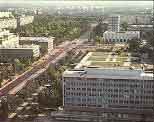 the road for eleven days, touring Moscow, Russia, and
Kiev in the Ukraine, and
Tbilisi, Georgia. The earlier cities had progressed us from modern to "old world", but with our arrival in
Uzbekistan, I felt that we had stepped right into the middle east, despite the
fact that Tashkent is a very modern city. There was just something about
the ambiance, the aura, the "feel" of the place. Perhaps it was
the combination of the language, the faces of the people, the buildings, the old
and the new. Perhaps it was the art objects on the walls and in the
lobbies. I don't really know, but it was interesting, different and
delightful.
the road for eleven days, touring Moscow, Russia, and
Kiev in the Ukraine, and
Tbilisi, Georgia. The earlier cities had progressed us from modern to "old world", but with our arrival in
Uzbekistan, I felt that we had stepped right into the middle east, despite the
fact that Tashkent is a very modern city. There was just something about
the ambiance, the aura, the "feel" of the place. Perhaps it was
the combination of the language, the faces of the people, the buildings, the old
and the new. Perhaps it was the art objects on the walls and in the
lobbies. I don't really know, but it was interesting, different and
delightful.
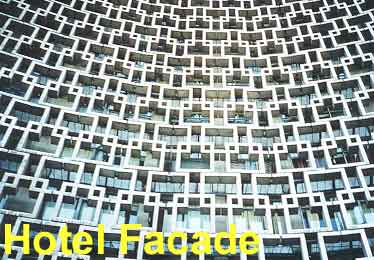 We had been told by our tour guide, not to drink the water and to get bottled water from the
hotel "floor attendant". However, we, on the fourth floor, were unable to locate the attendant, so we tracked down our tour guide, who finally found the attendant asleep on the bed
in one of our rooms. Not only was she out of bottled water, but there was none on any of the other floors, which meant no one could take their bed time pills until the bar opened after day break.
OK,, so we are having an adventure here. After all, this was a foreign country.. .a very
foreign country, to be sure, and over the next five days
We had been told by our tour guide, not to drink the water and to get bottled water from the
hotel "floor attendant". However, we, on the fourth floor, were unable to locate the attendant, so we tracked down our tour guide, who finally found the attendant asleep on the bed
in one of our rooms. Not only was she out of bottled water, but there was none on any of the other floors, which meant no one could take their bed time pills until the bar opened after day break.
OK,, so we are having an adventure here. After all, this was a foreign country.. .a very
foreign country, to be sure, and over the next five days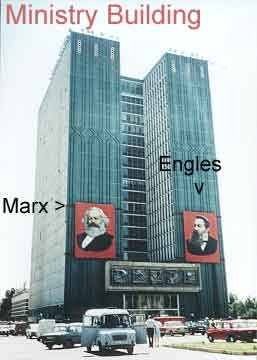 we would all be very glad we hadn't missed it.
we would all be very glad we hadn't missed it.
Tashkent is the capitol of Uzbekistan and the faces of the people are Asian and Turkish types.
Our city tour guide was Russian and the city itself seemed to be more European on the surface.
We were told that tragedy had hit the area. The Russians had diverted some rivers away the Aral Sea and, as a result, the sea had become saline, the fish had died and the sea is now drying up.
Consequently, the the fishing industry is past tense, (this was in 1990). As if that wasn't enough, many of the local people are developing strange new diseases, including various
cancers, according to our tour guide.
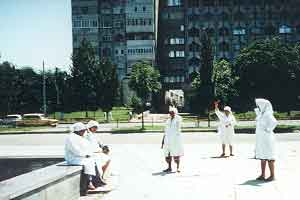 We were in a wide open, treeless park area when we encountered a group of, perhaps, a dozen or more Muslin
park cleaning ladies, taking a break. We were looking at them in their long,
white Muslim dresses and veils, as we walked toward them, and they were looking at us and started giggling like school girls.
They had spied, Joe, one of our group. He was wearing shorts, exposing his very well developed
legs...legs that could have belonged to a rock climber or aerobics instructor.
I guess in this country, Muslim ladies don't get a chance to see many
sixty year old men with such good looking legs. (Muslim men, as
well as women wear long robes.) We laughed right along with them, as
Joe did a little jig.
We were in a wide open, treeless park area when we encountered a group of, perhaps, a dozen or more Muslin
park cleaning ladies, taking a break. We were looking at them in their long,
white Muslim dresses and veils, as we walked toward them, and they were looking at us and started giggling like school girls.
They had spied, Joe, one of our group. He was wearing shorts, exposing his very well developed
legs...legs that could have belonged to a rock climber or aerobics instructor.
I guess in this country, Muslim ladies don't get a chance to see many
sixty year old men with such good looking legs. (Muslim men, as
well as women wear long robes.) We laughed right along with them, as
Joe did a little jig.
In 1966, Tashkent had suffered another tragedy in the form of a 6.5 earthquake which killed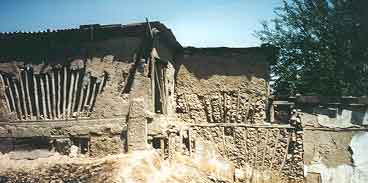 200 people, and leveled many of the older
structures. Our tour guide pointed out to us the broken homes and we could
see how these mud huts were constructed. Walls were built with beams
forming "V's". The spaces between were filled with rocks,
in some cases, the
size of two fists, over which, mud was cemented in and smoothed over. It
looked rather sturdy to me...until a 6.5 earthquake occurs.
200 people, and leveled many of the older
structures. Our tour guide pointed out to us the broken homes and we could
see how these mud huts were constructed. Walls were built with beams
forming "V's". The spaces between were filled with rocks,
in some cases, the
size of two fists, over which, mud was cemented in and smoothed over. It
looked rather sturdy to me...until a 6.5 earthquake occurs.
It is the custom, to erect a memorial to the
victims of such an event and, following a marriage 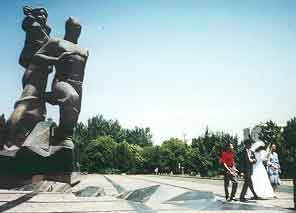 ceremony, the bride and groom visit the memorial to honor those relatives who could not be in
attendance, due to the fact they are deceased. While we were at the epicenter memorial of the
earthquake of '66, we witnessed a bride in her bridal dress and the groom laying flowers on the steps
of the monument. As we were leaving, a little girl came up to me and handed me a rose.
I was so touched.. .and I got her picture.
ceremony, the bride and groom visit the memorial to honor those relatives who could not be in
attendance, due to the fact they are deceased. While we were at the epicenter memorial of the
earthquake of '66, we witnessed a bride in her bridal dress and the groom laying flowers on the steps
of the monument. As we were leaving, a little girl came up to me and handed me a rose.
I was so touched.. .and I got her picture.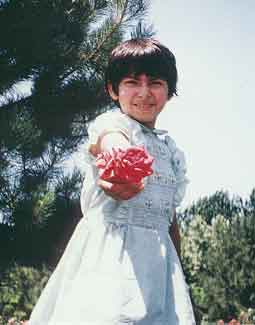
Later, while we were visiting the market place, another little girl came up to me and presented me with a beautiful violet gladiola. I began to wonder if it was "honor the elderly day". In retrospect, I believe it was my graying blond hair. Perhaps, it was these little girl's very polite way of getting close enough to get a better look at the blond-gray American with the long pony tail. There are not too many people in this area with my skin and hair color. But, my goodness, what sweet, kind and friendly people they have in these parts!!! I am so glad I chose to come this way.
Samarkand, Uzbekistan, USSR
July 1990
Vicky Blitz
Without disrespect, and with mild amusement, I must mention a few things about
my hotel room. It is obvious that often, the people who are installing bathroom
equipment in modern hotels, have never seen a western
bathroom and therefore they don't have the big picture of what our bathrooms
should look like. And yet, they are trying to accommodate us, and really, we
should be grateful. The traveler must keep in mind, when traveling in these
eastern and middle eastern countries, that people in these parts probably think
it is unsanitary for we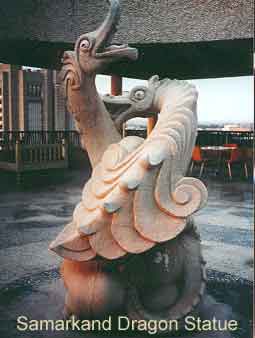 westerners to sit on a toilet, which someone else has
already sat upon. They have, instead, a hole in the ground, over which they
squat, to do their business. So, in my bathroom in Samarkand, they had the
equipment alright, but it was a very small room and no shower curtain. To take a
shower, I had to first remove the towels and the toilet paper, or else they
would have been soaked. AND, the toilet was only twelve inches off the floor.
Where did they ever find them that low?
westerners to sit on a toilet, which someone else has
already sat upon. They have, instead, a hole in the ground, over which they
squat, to do their business. So, in my bathroom in Samarkand, they had the
equipment alright, but it was a very small room and no shower curtain. To take a
shower, I had to first remove the towels and the toilet paper, or else they
would have been soaked. AND, the toilet was only twelve inches off the floor.
Where did they ever find them that low?
Back to the bedroom. There was the obligatory framed picture in the room, but,
what was that guy thinking, to hang it only four inched from the ceiling? And
then, one more. Some one had purchased an electric light sconce to hang over the
bed. But they were designed, of course, to be installed inside the wall. And,
you guessed it! The exposed electrical wires, hung from the lamp, outside the
wall for about eighteen inches before disappearing into the wall, where they
should have been in the first place..
Without air conditioning, the room was so hot, I was unable to sleep until I
opened the door to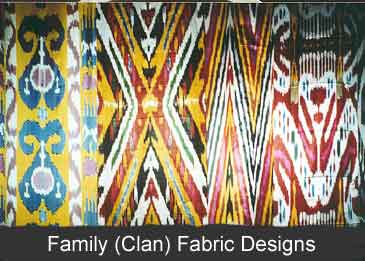 the balcony. It was a lovely cool night ... outside.
So I
slept until a barking dog woke me about five the next morning.
the balcony. It was a lovely cool night ... outside.
So I
slept until a barking dog woke me about five the next morning.
Ah, but that barking dog was a blessing in disguise because it made me the
first to arrive at breakfast. We were given a private dinning room with a long
table, covered by a gleaming white table cloth, sparkling silverware and dishes.
The waiters were immaculate in their spotless white coats and dark freshly
pressed trousers. Running the entire length of the room were French doors which
were open to the desert winds which gently wafted through the white chiffon full
length curtains. Amid this scene of elegance, the waiters were placing the
breakfast rolls on the table as I arrived, and, which, to my horror were
immediately covered by flies. Needless to say, being the first to arrive, I
selected MY breakfast roll from the bottom.
When the others arrived and began to compare notes, nearly everyone (including
myself) were beginning to come down with the tsar's revenge, to some degree, but
our tour guide was prepared to dole out little pills that, at least, kept us
going. A good thing, too. This was NOT the day to spend in bed.. .not in
Samarkand. This was NOT th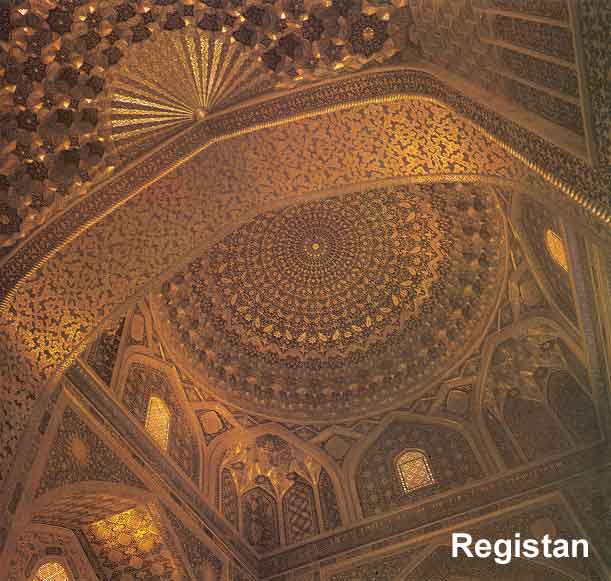 e day to miss!
e day to miss!
The following is a quotation from the beautiful Samarkand guide book I obtained
there, and I wish to emphasize, it my opinion, it does not exaggerate.
"Samarkand stood on the cross-roads of caravan routes and played an
important role in the economic ties of the countries of the East. Many centuries
ago, it was a center of ancient civilization and the seat of historical and
cultural traditions of the peoples of Central Asia.
"Samarkand has great attractive force. Indeed, there are few cities in the
world that can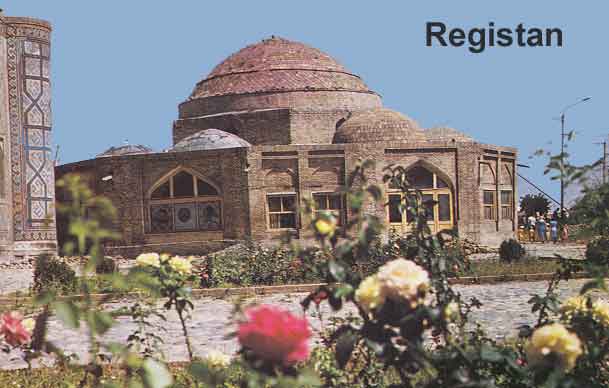 boast of a history of more than two and a half millennia, that
have such charm and inimitable beauty. It is not for nothing that poets and
historians of past ages attributed to Saniarkand such flowery epithets as
'Garden of Eden of the ancient East', 'Precious gem of the Eastern Moslem
world', 'Beauty of sub lunar countries', and Rome of the East'."
boast of a history of more than two and a half millennia, that
have such charm and inimitable beauty. It is not for nothing that poets and
historians of past ages attributed to Saniarkand such flowery epithets as
'Garden of Eden of the ancient East', 'Precious gem of the Eastern Moslem
world', 'Beauty of sub lunar countries', and Rome of the East'."
Just by being a caravan cross-roads, Samarkand became a target for many wars
and conflicts. Alexander the Great (329 AD), Genghis Khan (1220) and Tamerlane
(he died in 1405 and was buried there), along with many others who raped,
tortured and killed the people and destroyed the city. Now, although I am
embarrassed to have to admit this, I had never heard of Tamerlane until my visit
to Samarkand, but became very familiar with him before leaving. So when I
returned home, I looked it up in my college "History of Civilization"
text book and was shocked to find no mention of him. Well, let me mention him
here.
people and destroyed the city. Now, although I am
embarrassed to have to admit this, I had never heard of Tamerlane until my visit
to Samarkand, but became very familiar with him before leaving. So when I
returned home, I looked it up in my college "History of Civilization"
text book and was shocked to find no mention of him. Well, let me mention him
here.
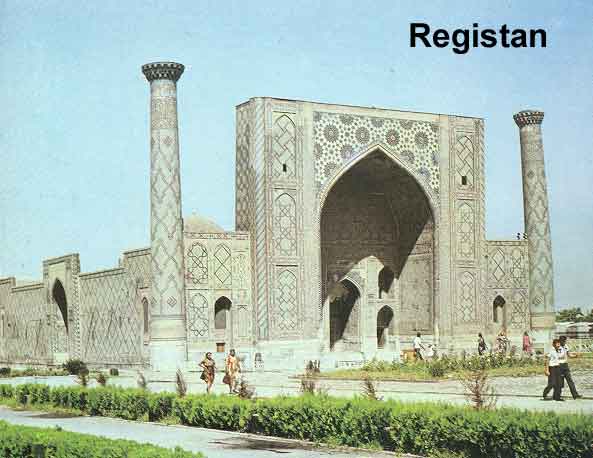 after his victory there, brought in prominent architects, artists, craftsmen and builders from all over the East.
Specifically, he brought in 200 stone masons from Azerbaijan, Persia, India; 500 other workmen cut the stone to be used from nearby quarries and much of his city was completed within five years.
Tamerlane then made this beautiful city his capitol and, before he died in 1405, he had established law and order, and made this place into a learning center which produced great scholars.
In a word, he is, in THIS part of the world, a HERO.
after his victory there, brought in prominent architects, artists, craftsmen and builders from all over the East.
Specifically, he brought in 200 stone masons from Azerbaijan, Persia, India; 500 other workmen cut the stone to be used from nearby quarries and much of his city was completed within five years.
Tamerlane then made this beautiful city his capitol and, before he died in 1405, he had established law and order, and made this place into a learning center which produced great scholars.
In a word, he is, in THIS part of the world, a HERO.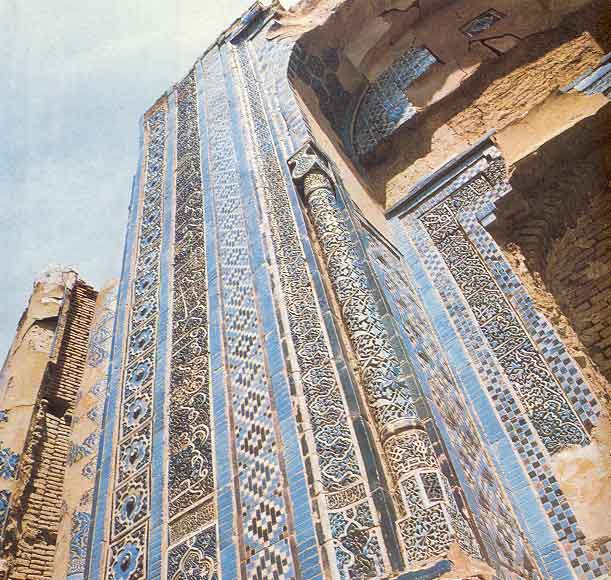 comprised of twenty mausoleums, containing the remains of the wealthy, the famous, the educated of the time, and their wives and children.
It struck me how much they used various shades of blue in their ceramic tiles, ranging in size from three quarter inch squares to foot long sections.
Art students will tell you that the most difficult of all the colors is blue, because we don't know how to preserve the original color...it fades.
Well, folks, come take a look at THESE blues. They range from dark, to medium, to light, with some shades going toward the greens, and these colors are 600 years old.
comprised of twenty mausoleums, containing the remains of the wealthy, the famous, the educated of the time, and their wives and children.
It struck me how much they used various shades of blue in their ceramic tiles, ranging in size from three quarter inch squares to foot long sections.
Art students will tell you that the most difficult of all the colors is blue, because we don't know how to preserve the original color...it fades.
Well, folks, come take a look at THESE blues. They range from dark, to medium, to light, with some shades going toward the greens, and these colors are 600 years old.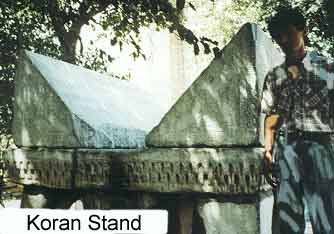 at the
opposite side of the spacious marble courtyard. The entrance of the courtyard was a
huge, impressive gateway with two minarets (originally 50 meter high) at either side.
In the courtyard, stands a rather strange structure I was unable to identify. I finally asked our guide what had been it's purpose and he said it had held an enormous Koran, the book equivalent to the Bible's old
Testament. Because it was so large, I took a picture of our guide standing next to it for comparison of size.
Tamerlane intended to build this complex to exceed everything he had seen in other lands and I'm sure he accomplished his goal.
It was built following his successful campaign in India, and the Indian influence is obvious.
Today, it is,
regrettably, in ruins, but an attempt was being made, back in 1990, by the Russian government to restore it.
at the
opposite side of the spacious marble courtyard. The entrance of the courtyard was a
huge, impressive gateway with two minarets (originally 50 meter high) at either side.
In the courtyard, stands a rather strange structure I was unable to identify. I finally asked our guide what had been it's purpose and he said it had held an enormous Koran, the book equivalent to the Bible's old
Testament. Because it was so large, I took a picture of our guide standing next to it for comparison of size.
Tamerlane intended to build this complex to exceed everything he had seen in other lands and I'm sure he accomplished his goal.
It was built following his successful campaign in India, and the Indian influence is obvious.
Today, it is,
regrettably, in ruins, but an attempt was being made, back in 1990, by the Russian government to restore it.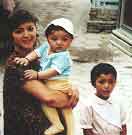
Leaving the Bibi-Khanim, we walked through the adjacent market place where the merchants were selling their wares.
I always have with me, inexpensive little "exchange" items to give children or even adults, when they permit me to take their pictures.
On this trip I had purchased pencils coated with different holographic designs, which changed colors as
the pencil moved.
As we passed among the local people, in route back to our bus, I was taking
pictu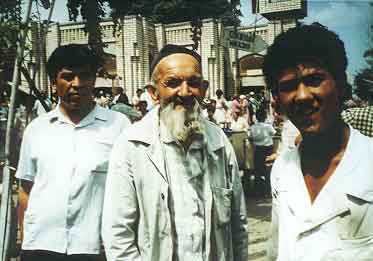 res in exchange for the pencils, until I had run out, and was waiting to board the bus.
A very large and powerful woman approached me with a young girl and wanted their picture taken.
I complied. However, she wanted a pencil and was quite emphatic about it.
So, with hand signals, I tried to explain that I had no more pencils, but I had
something to give her, but it was on the bus. Well, she thought I was trying to get away from her and started to board the bus
res in exchange for the pencils, until I had run out, and was waiting to board the bus.
A very large and powerful woman approached me with a young girl and wanted their picture taken.
I complied. However, she wanted a pencil and was quite emphatic about it.
So, with hand signals, I tried to explain that I had no more pencils, but I had
something to give her, but it was on the bus. Well, she thought I was trying to get away from her and started to board the bus
 also.
Fortunately, the bus driver
intervened, preventing her from getting on, and I quickly located a couple perfume samples.
I reached through the door to give them to her. I was not about to get off the bus.
I wasn't sure how she would vent her anger if she was displeased, and I considered myself lucky this incident hadn't happened a block or two away.
also.
Fortunately, the bus driver
intervened, preventing her from getting on, and I quickly located a couple perfume samples.
I reached through the door to give them to her. I was not about to get off the bus.
I wasn't sure how she would vent her anger if she was displeased, and I considered myself lucky this incident hadn't happened a block or two away.
We visited the Guri-Emir, which means "grave of the emir" (emir, meaning ruler, ruler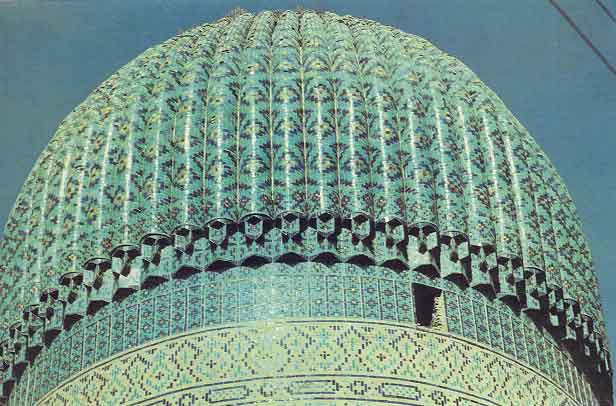 meaning Tamerlane). In addition to Tamerlane, however, this mausoleum houses the remains of his favorite grandson, two of his sons, and Ulughbek (the great
astronomer who was also his grandson).
Never have I seen a more beautiful dome than the one that highlights this structure.
Of course there are those ubiquitous blue tiles, but it has a unique flouting that give it such a charm.
I
include it here with this paragraph.
meaning Tamerlane). In addition to Tamerlane, however, this mausoleum houses the remains of his favorite grandson, two of his sons, and Ulughbek (the great
astronomer who was also his grandson).
Never have I seen a more beautiful dome than the one that highlights this structure.
Of course there are those ubiquitous blue tiles, but it has a unique flouting that give it such a charm.
I
include it here with this paragraph.
Ulu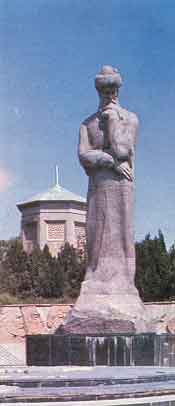 ghbek is known to the world for his astronomical catalogue "Zidzhi-Guragan", more commonly known as "Uluglibeck's tables of stars". A large group of prominent scholars worked with him for many years and completed the tables in 1437. Although they worked without the aid of a telescope, they recorded the co-ordinates of 1,018 stars with surprising
accuracy. For example, their estimated duration of the celestial year is only off by 52.4 seconds,
according to our modem technology. After his death, his observatory was destroyed by fanatics, but
now, there is a little museum near the original site, which is very interesting and well worth the visit.
ghbek is known to the world for his astronomical catalogue "Zidzhi-Guragan", more commonly known as "Uluglibeck's tables of stars". A large group of prominent scholars worked with him for many years and completed the tables in 1437. Although they worked without the aid of a telescope, they recorded the co-ordinates of 1,018 stars with surprising
accuracy. For example, their estimated duration of the celestial year is only off by 52.4 seconds,
according to our modem technology. After his death, his observatory was destroyed by fanatics, but
now, there is a little museum near the original site, which is very interesting and well worth the visit.
As much "in awe" as I had been to this point in Samarkand, nothing had prepared me for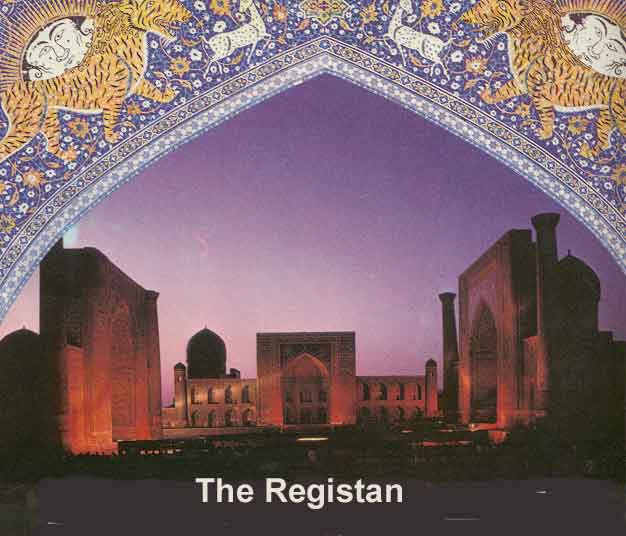 what we found at Registan [see marked pictures, earlier in this text]. The three main structures which boarder the Registan square, were completed in 1420, 1636 and 1660 A.D. and were once the heart of the city and a center for commercial and artisan
endeavors. However, the original purpose was for a religious university, housing 100 students, and it is believed that Ulughbeck taught them higher mathematics.
what we found at Registan [see marked pictures, earlier in this text]. The three main structures which boarder the Registan square, were completed in 1420, 1636 and 1660 A.D. and were once the heart of the city and a center for commercial and artisan
endeavors. However, the original purpose was for a religious university, housing 100 students, and it is believed that Ulughbeck taught them higher mathematics.
Bukhara, Uzbekistan,
USSR July 1990
Vicky Blitz
The treeless, four hour long, desert road to Bukhara was so boring with nothing to see, I reflected back to the times of the
caravans that came through these parts at an even slower pace. Unless there was a sand storm, or the men and animals acted up, it must have been a pretty dull life. I mused that the men of the
caravan routes must have done an awful lot of meditating.
If I worked for the tour company for this trip, I would have scheduled the itinerary to put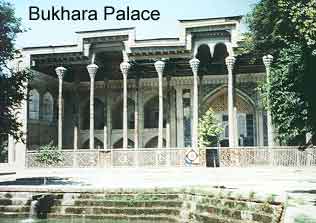 Bukhara first and Samarkand second, because, after seeing Samarkand, Bukhara was a let down and that is a bit of a shame. The structures were made, mostly, of wood and stone, with none of those beautiful ceramic tiles. Probably, this is the way
Samarkand was before the arrival of Tamerlain.
Bukhara first and Samarkand second, because, after seeing Samarkand, Bukhara was a let down and that is a bit of a shame. The structures were made, mostly, of wood and stone, with none of those beautiful ceramic tiles. Probably, this is the way
Samarkand was before the arrival of Tamerlain.
Of course, Bukhara was, and is, an oasis. We toured the fortress, a mosque and a nice little
museum, all of which would have been a lot more interesting, had it not been quite so hot and had our tour group been not so ill. Everyone, it seemed, was coming down with "it".. .chills, fever,
diarrhea, vomiting, etc. (Perhaps that is why they had placed Samarkand ahead of Bukhara on the itinerary.) However, our tour guide supplied us with some very helpful pills for such an
occasion.
In the museum we saw ancient tools, utensils, swords, costumes, looms, spinning wheels,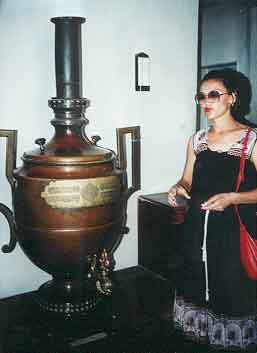
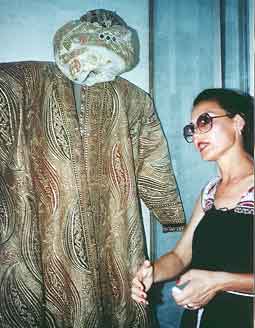 musical instruments, ceramic plates,
metal ware, art objects, etc. How interesting it was to compare their old wooden tools to the old wooden tools from other parts of the world. The principles for most tools were usually the same, but the difference was in the creative style.
musical instruments, ceramic plates,
metal ware, art objects, etc. How interesting it was to compare their old wooden tools to the old wooden tools from other parts of the world. The principles for most tools were usually the same, but the difference was in the creative style.
During our visit to the fortress, we passed some of the jails, which were dark, cramped and hot, and situated so that there was no relief from a breeze of any kind. However, our guide informed us that when they really wanted to punish someone, they had other jails under the stables. There, the ceilings did not prevent "things" from dropping down on the inmates and the cells were never cleaned.
Then we heard the story of the two Englishmen, who visited this outpost many years ago. It seems the first was sent on orders from his queen, with all the proper papers. Upon arrival, he
inadvertently broke three rules. First, he rode his horse through the gate, instead of walking. Second, he was improperly dressed. (We don't know what that means. Had he taken off his shirt?) And third, upon meeting the emir, he was offered a gift and turned it down. (Don't
yo u wonder what might have been the gift?) So, they threw him in jail and there he sat until the second Englishman arrived two years later.
u wonder what might have been the gift?) So, they threw him in jail and there he sat until the second Englishman arrived two years later.
Now, the second Englishman had not actually planned to visit the fortress and, therefore, was not equipped with any papers of introduction, at all. According to the story, he was just passing by and decided to "drop in". A big mistake. They immediately threw him in jail, and two years later, beheaded both of them. Consider the times.
THINK GLOBALLY - ACT LOCALLY - PRAY FOR WORLD PEACE